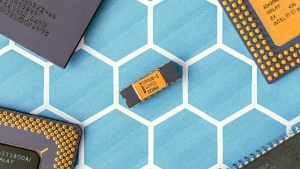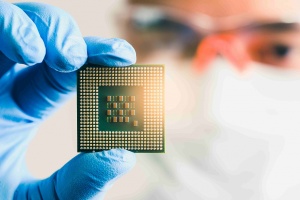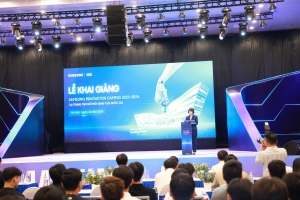Semiconductor success in reach with investment
The semiconductor industry has developed rapidly in recent years. Is it appropriate for a developing country like Vietnam to participate in this industry now?
| Lee Young Hee, director of the Center for Integrated Nanostructure Physics at the Institute for Basic Sciences at Sungkyunkwan University, and Park Inkyu, head professor at the Department of Mechanical Engineering at the Korea Advanced Institute of Science and Technology |
Hee: Currently, silicon technology plays a dominant role in the semiconductor industry, driven by Moore’s Law. However, this technology is gradually reaching fundamental limits, such as limits on shrinking sizes to a few nanometres and quantum mechanical limits. Therefore, it is crucial to seek new technologies to replace silicon. Vietnam can seize this opportunity to compete with leading countries in the semiconductor field.
Simply continuing silicon technology will not give Vietnam a competitive advantage. Instead, your country should focus on developing breakthrough technologies, concentrating on developing new materials and improving device performance to compete in the future, especially in quantum computing.
Additionally, the key factor for Vietnam to enter the semiconductor industry at this time is its abundant workforce and hard-working, creative work culture. I have had the opportunity to work with many Vietnamese students and am truly impressed by their dedication and contribution. This is a significant advantage that Vietnam needs to leverage for semiconductor industry development.
However, the semiconductor industry is costly. To avoid being overwhelmed by the extravagance of this industry, Vietnam needs to supplement necessary infrastructure, including shortages in high-level human resources and modern equipment. Nevertheless, I still believe that Vietnam is a top contender in the semiconductor industry game.
What are the emerging trends or new technologies in the global industry that Vietnam should pay attention to and leverage?
Inkyu: Currently, there are many important trends in the semiconductor industry, but I believe that the two most potential areas that Vietnam should focus on are semiconductor devices for AI processing and GPUs with high speed and large memory capacity. The demand for AI is increasing rapidly, requiring dedicated semiconductor devices to process AI algorithms effectively.
Next is GPUs with high computational power and large memory capacity, as big data processing and machine learning are becoming increasingly common in various fields such as healthcare, finance, and manufacturing, requiring GPUs with higher computational performance and large memory capacity for storing and accessing data quickly.
These are also crucial trends in the industry in South Korea. I believe these are areas that Vietnam should focus on researching and investing in for the future development of the semiconductor industry.
South Korea has a developed semiconductor industry. Do you have suggestions to promote industry development in Vietnam?
Hee: I have been following and studying the semiconductor industry in Vietnam for some time, and I can honestly say that building and developing this new industry will require time and effort. In South Korea, we have spent many years investing in research, human resource training, and building modern infrastructure. Therefore, I believe that the first thing Vietnam should do is focus on educating and training high-quality human resources for the industry.
I also suggest establishing an agency like the National Research Laboratory, focusing on the semiconductor industry. This laboratory will serve as a research, development, and high-quality human resource training centre for the industry. I have had the opportunity to visit Hanoi University of Science and Technology several times and collaborate with professors. We have also provided equipment to support teaching and research.
Training students with appropriate equipment for practical purposes is extremely important. However, this process takes time and resources. To improve the quality of education, I believe there needs to be strong investment from the government to improve infrastructure and equip universities with modern facilities.
What are the challenges or limitations that Vietnam may encounter in the process of developing the semiconductor industry?
Inkyu: I am very optimistic about the future of the semiconductor industry in Vietnam. To develop even faster, I believe Vietnam needs to enhance cooperation with leading companies in various countries, such as close collaboration with leading companies in South Korea, the United States, or Europe to quickly catch up with advanced technology.
Building an open cooperation platform is very important. Recently, I have cooperated with China quite regularly and have seen them invest heavily in scientific and technological research, as well as international cooperation. They invest heavily in large research funds to promote international cooperation by sending experts abroad or inviting experts from abroad. If Vietnam can invest more in human exchanges and idea sharing through open cooperation platforms, this will help promote rapid development for the semiconductor industry and related research.
Could you share specific research areas or technological breakthroughs in the field that Vietnam could apply to promote sustainable development goals?
Inkyu: Currently, the semiconductor industry is conducting research projects, especially in sensor technology. Many scientists are focusing on neuromorphic devices.
Neuromorphic devices simulate the functions of the human brain or nervous system. Instead of processing information in the traditional Von Neumann structure, these devices simulate sensory systems, nervous systems, and brain operations to process data more efficiently in terms of energy and improve the data transmission process from sensors to servers and processing.
Therefore, neuromorphic semiconductors or neuromorphic processing play an important role in promoting sustainable development as they help save energy and process data more efficiently.
 | Vietnam commits $1.08 billion to train 50,000 semiconductor engineers by 2030 Vietnam has underscored its ambition to develop a skilled workforce for the semiconductor industry, aligning with its vision to deeply integrate into the global value chain, spurred by robust industry growth and strategic international partnerships. |
 | Phenikaa to train 8,000 semiconductor chip design engineers Phenikaa Group sets the goal of training more than 8,000 semiconductor chip design engineers with international certificates by 2030. |
| Call to arms for semiconductor roles Chip design is set to boom in Vietnam in the coming years, with many investors entering the market. However, human resource training needs more backing for the industry to achieve high quality and capture opportunities. |
| Vietnam to become key link in semiconductor value chain The Vietnamese government provided positivity and expectation for the country to develop its semiconductor industry at a pivotal conference on April 24 focusing on human resource development. |
 | Samsung and NIC to train 200 students Samsung and the National Innovation Centre (NIC) kicked off the Samsung Innovation Campus (SIC) in Hoa Lac Hi-tech Park on May 3, with six training courses for 200 students. |
What the stars mean:
★ Poor ★ ★ Promising ★★★ Good ★★★★ Very good ★★★★★ Exceptional
Related Contents
Latest News
More News
- Global partnerships key to Vietnam’s IFC development (December 26, 2025 | 16:18)
- Vingroup pulls out of bid to invest in North-South high-speed railway (December 26, 2025 | 11:42)
- Strengthening supply chains through trade promotions and customs reform (December 24, 2025 | 14:00)
- PM orders investment model for North–South high-speed rail (December 22, 2025 | 17:43)
- LS Eco Energy to invest in Vietnam rare earth sector (December 22, 2025 | 17:31)
- Government moves to establish International Financial Centre (December 21, 2025 | 21:00)
- Vietnam's IFC to target global investment flows (December 21, 2025 | 18:00)
- Two national hospitals expand capacity with new facilities (December 20, 2025 | 09:00)
- Ha Tinh breaks ground on major Vingroup industrial and energy projects (December 19, 2025 | 18:24)
- EVN launches major power infrastructure projects nationwide (December 19, 2025 | 18:17)

 Tag:
Tag:





















 Mobile Version
Mobile Version